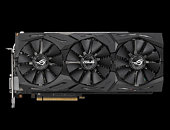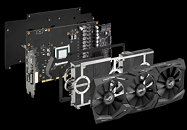- Joined
- Oct 9, 2007
- Messages
- 47,417 (7.51/day)
- Location
- Hyderabad, India
| System Name | RBMK-1000 |
|---|---|
| Processor | AMD Ryzen 7 5700G |
| Motherboard | ASUS ROG Strix B450-E Gaming |
| Cooling | DeepCool Gammax L240 V2 |
| Memory | 2x 8GB G.Skill Sniper X |
| Video Card(s) | Palit GeForce RTX 2080 SUPER GameRock |
| Storage | Western Digital Black NVMe 512GB |
| Display(s) | BenQ 1440p 60 Hz 27-inch |
| Case | Corsair Carbide 100R |
| Audio Device(s) | ASUS SupremeFX S1220A |
| Power Supply | Cooler Master MWE Gold 650W |
| Mouse | ASUS ROG Strix Impact |
| Keyboard | Gamdias Hermes E2 |
| Software | Windows 11 Pro |
ASUS today introduced the Republic of Gamers (ROG) STRIX Radeon RX Vega 64 O8G graphics card, among its first (and probably the first) custom-design RX Vega 64 to hit the markets (model: ROG-STRIX-RXVEGA64-O8G-GAMING). The card combines a custom-design PCB by ASUS, with the company's latest generation DirectCU III cooling solution the company deploys on its STRIX GTX 1080 Ti graphics card. The cooler features a heat-pipe direct-contact base, from which the heat-pipes pass through two aluminium fin-stacks on their two ends, which are ventilated by a trio of 100 mm spinners. The fans stay off when the GPU is idling. The cooler features RGB multi-color LED lighting along inserts on the cooler shroud, and an ROG logo on the back-plate.
Moving over to the sparsely populated PCB (thanks in part to AMD's HBM2 move), the card draws power from a pair of 8-pin PCIe power connectors, conditioning it for the GPU with a 13-phase VRM. The O8G variant features factory-overclocked speeds that are close to those of the RX Vega 64 Liquid Edition, although ASUS didn't specify them. There's a "non-O8G" variant that sticks to reference clock speeds, boosting to around 1495-1510 MHz. What ASUS is really selling here is better clock sustainability under load, lower noise, and zero idle-noise; besides all the ROG STRIX bells and whistles. The card also drives two 4-pin PWM case fans in-sync with the cards, like most ROG STRIX graphics cards from this generation. ASUS also rolled out the ROG STRIX RX Vega 56, which features the same exact PCB, and sticks to AMD reference speeds. The company didn't reveal pricing.





View at TechPowerUp Main Site
Moving over to the sparsely populated PCB (thanks in part to AMD's HBM2 move), the card draws power from a pair of 8-pin PCIe power connectors, conditioning it for the GPU with a 13-phase VRM. The O8G variant features factory-overclocked speeds that are close to those of the RX Vega 64 Liquid Edition, although ASUS didn't specify them. There's a "non-O8G" variant that sticks to reference clock speeds, boosting to around 1495-1510 MHz. What ASUS is really selling here is better clock sustainability under load, lower noise, and zero idle-noise; besides all the ROG STRIX bells and whistles. The card also drives two 4-pin PWM case fans in-sync with the cards, like most ROG STRIX graphics cards from this generation. ASUS also rolled out the ROG STRIX RX Vega 56, which features the same exact PCB, and sticks to AMD reference speeds. The company didn't reveal pricing.





View at TechPowerUp Main Site





